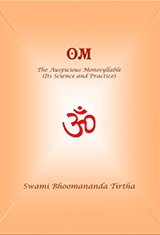Resources
Collective Sādhanā – Its Spiritual Dimension
Swami Bhoomananda Tirtha

Collectivity contributes to your interactional as well as individual sadhana. Just as contemplation becomes ineffective without interactional sadhana, the combined aspect of contemplation and interactional sadhana will not be sufficiently effective unless you take up a collective programme.
Hariḥ Om Tat Sat. Jai Guru.
We had been discussing different projects that our CIRDs should take up. By calling them simply as “project work” we are not, I think, bringing out the element of spiritual sublimity; the sādhanā effect is not getting expressed or highlighted.
I would like you to understand the three-fold aspect in spiritual pursuit. One is the individual effort. Here, your sādhanā is restricted to yourself. It is taken up by you alone. It concerns your own mind, intelligence and inner personality. Another is the interactional aspect. The third is the collective endeavour. While interactional sādhanā strengthens, deepens and enhances your individual pursuit, both these are verily enriched and empowered by taking up collective sādhanā. Only when there is a collective programme, all of you will come together and join. This “collectivity” is very important in human life. Understand that all the three spiritual aspects are complementary to each other.
I was told of a documentary shown on television, in which a herd of elephants was migrating from one place to another because of shortage of water. The entire herd was moving. Amongst them was a mother along with her baby elephant. Naturally the baby was not able to move as fast as the elder ones. So the mother was walking slower, along with the baby. After some time, the herd was going ahead, with the mother and the baby trailing behind.
Then the herd used to stop, allowing the mother and the baby to catch up. They went on moving like this. Eventually the baby became more and more tired. Ultimately it came to a point when the baby was not able to walk further. The mother sensed it. The herd also sensed it. What could they do? Initially, they all waited. And there came a time when the mother decided to leave the baby behind and walk forward. Repeatedly she was turning back, looking at the forlorn child. Who knows what all were the emotions of the mother elephant! Steadily but surely the herd proceeded. The elephants went away. What do you find in this? There was sufficient collectivity and consideration on the part of the herd towards the mother elephant and the baby. And ultimately the mother had to abandon the baby because of the impossibility of conducting it further. As elephants, they have no means of lifting the baby, and carrying it along – they do not have that mechanism or intelligence.
But in the case of human beings, this sense of collectivity is much more. You should understand that one can not live disconnected from the world. If one attempts it, it cannot be a good and noble life. An individual is a unit of the society, and the society is an aggregate of individuals. If one is not mindful of his family, do you consider him to be a mature, good human being? No! In the same manner, a family or an individual who is unmindful of the society is almost like a cancerous element in the society.
You may have a good profession. You may be intelligent. You may have skills. You may have affluence and riches. But unless you have a societal dimension in you, all the other things become insignificant. It is not that one individual will be able to do all that the society needs. But a small proportion of societal dimension you must have. This is how our collective effort in CIRD becomes important.
Our group is dedicated to Brahmavidyā pursuit. So, Brahmavidyā dissemination becomes a vital limb of the organization. Perhaps, people like us, Sannyāsins, alone will be able to do the actual dissemination effectively. But we require a lot of assistance from all of you. Our efforts will be effective only when the efforts reach the people. So, making the people participate in the mission becomes imperative. There, I think, every one of you should excel.
See, a drama cannot serve its purpose if there are no spectators. Similarly, we will not be able to do our work unless the recipients of the work in the society are made aware of it. Every one of you is important in this facet. Now, when you look at the collective work with this attitude, you will find that the task sublimates and enriches you.
Collectivity contributes to your interactional as well as individual sādhanā. Just as contemplation becomes ineffective without interactional sādhanā, the combined aspect of contemplation and interactional sādhanā will not be sufficiently effective unless you take up a collective programme.
In collective sādhanā, there is a kind of an obligation which compels you to be sensitive to others’ feelings. If you don’t go for a satsang organized by the Centre, someone or the other will ask: “Why did you not come?” That itself becomes a persuasion. Suppose a work is allotted to you, and if you are tardy in doing it, others will say: “Did you not take it up? Was it not interesting to you? How is it that you ignored it?”
Sometimes the questions may be harsh. Sometimes it may be a suffering because of the neglect noticed by others or by yourself too. These emotions will have an impact on you. I think you should take note of them. You should be sensitive to your own feelings and also to those of others. When you do so, you will find that the mind gets enriched.
To deal with someone who is quarrelsome or resistive is always hard. And if you are able to do it, will not your mind become nobler? He is harder, but you are nobler. Another man, let us say, is very argumentative – generally he does not agree with anything easily. Listening to his argument, see whether you can silently do something more by action.
All these interactions thrown on you during the collective sādhanā will enrich and empower your personality. Thus you will find sufficient compulsion and responsibility in a collective effort.
When I was in Kolkata, before taking up sannyāsa, reading scriptures, I thought that spiritual life meant sitting all alone and getting absorbed in samādhi several hours of the day. In one of the discussions I had with my Gurudev, he said: “If silence and surrender to samādhi are the spiritual ideals leading to the crowning fulfillment of the pursuit, then how is it that Vālmīki, Vasiṣṭhadeva and the others wrote so much about spirituality? Could they have written these epics without ample fulfillment and enlightenment? Having had enlightenment and fulfillment, thereafter, did they keep quiet or did they write volumes on the subject?”
If our spirituality only amounts to the experience of the individual, and nothing more need be done, then there would have been only one line in our scriptures. What could that be? “Do sādhanā, realize yourself, realize the inner splendour, and then drop your body!”
Think of Yogavāsiṣṭha Ramayana – there are 32,000 Sanskrit verses. Think of Ramayana – it has 24,000 verses; Mahabharata has 125,000 verses. How or why did Vālmīki or Vedavyāsa write so much? It must have been a stupendous task – writing, going through the manuscript and then editing all over. How many people must have helped him! But for their efforts, would we have inherited all this?
So, before long, my ideas about spiritual perfection necessarily had to undergo a change. I don’t remember exactly when, but shortly I started feeling: “I am going to be like Sri Krishna – active till the very last breath. As long as this activity is beneficial to people – enriching them and empowering them in their life – why should I not remain active? If people don’t want me, if they don’t like my work, then I will stop. As long as it is useful and valuable to the others, I will continue to be active.” It was a decision, natural to me. It was an appeal, generated by my own inner being.
Why did I tell you this? In the actual pursuit and fulfillment of spiritual sādhanā, sooner or later you must be a participant in a societal effort. What kind of an effort, will depend upon you and the necessity in the situation. But that societal aspect is very, very important. Individual sādhanā will not be as blossoming as individual sādhanā coupled with interactional sādhanā. And both will not be so much blossoming as with a collective effort in which you become a participant. Remember this.
Hariḥ Om Tat Sat. Jai Guru.
From Vicharasethu – December 2008

“An individual who is unmindful of the society is almost like a cancerous element in the society.”
“In collective sadhana, there is a kind of an obligation which compels you to be sensitive to others’ feelings. ”
“All these interactions thrown on you during the collective sadhana will enrich and empower your personality.”
you might be interested in

Swami Bhoomananda Tirtha
106 – by Swami Bhoomananda Tirtha – I am the Consciousness

Ma Gurupriya
190 – by Swamini Ma Gurupriya – Keep the mind on God

 662 views
662 views

 Add to Favorites
Add to Favorites Add to Reading List
Add to Reading List







